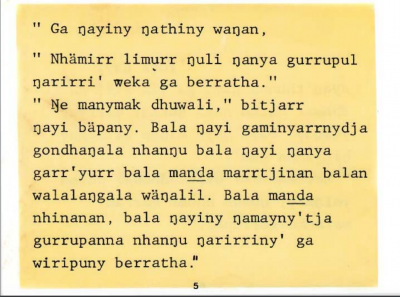 [1]
[1]Cover of the book “Bäruwuŋu mala wäŋa bunhawuy” Author: Djäwa, Illustrator: Yambal, written in the Gupapuyŋu language of Australia available at the Living Archive of Aboriginal Languages.
The following story was originally published as a case study of the Angkety map [2] – digital resource report produced by First Languages Australia. It is republished here with permission.
The Living Archive of Aboriginal Languages [3] project began with a commitment to develop a digital archive to support and enhance Australian Aboriginal knowledge practices.
The archive contains digitised material in Indigenous languages from the Northern Territory [4], with an initial focus on sourcing material from area schools that had a bilingual education program. These schools had literature production centres, which produced books in local languages. Teacher–linguists and literate production supervisors recorded a wide array of stories: versions of old-time children’s stories; pre- and post-contact histories; books about the environment, hunting, bush medicines, ghost stories, creation stories, stories of memorable events, life stories, conception stories, and cautionary tales. There were readers, curriculum documents, bilingual magazines and newspapers. Stories came from schoolchildren, community members, and community elders.

Searching Living Archive map according to location or language.
While some of the books are still available in the communities, books from some sources had dispersed and were retrieved from small private and large public collections from around Australia. The copyright holders (e.g. the Northern Territory Department of Education) gave permission to digitise the books, and each named contributor was also sought (or family members of those who had passed away) to give permission for the books to be made public on the open-access website.
The archive now contains hundreds of books in over 25 languages from communities across the Northern Territory. A highly visual interface allows users to access the books through a map where they can click on either a language or a place, and cover images of the books are presented for selection. Standard search and browse options are also available, searching both metadata and full text. Most of the books are illustrated, and many have English translations. In consideration of the preservation and presentation needs of the archive, multiple versions and formats of each item are created in the digitisation process. Books are published in the archive as PDFs, accompanied by Unicode text-only versions, while high-resolution preservation image scans are available on application. Some have been published as talking books, combining the original printed page with newly recorded readings. The provision of the material in different formats opens up potential uses for the resources.
 [5]
[5]Cover of the book “BE WE 93” Author: Marrŋanyin, B. Illustrator: Wadaymu, P., written in the Djambarrpuyŋu language of Australia available at the Living Archive of Aboriginal Languages.
Publishing the components of image and text makes the archive a great source of content for creating resources in the future, in collaboration with the story owners. It provides flexibility for people to adapt the material to their own use, such as updating text, adding new images, creating new ways to engage with the content.
A Creative Commons licence [6] allows non-commercial use of the materials with appropriate attribution. The process of reformatting reflects the activity and excitement that surrounded the original preparation of the books—the recording, the transcribing, the illustrating, the checking, the making, printing, collating, and distributing. It is this activity, and the ability for the material in the archive to be added to, edited, updated, which keeps it alive.
The archive balances the competing needs for material to be held as representation of
knowledge, and for the archive to be performative, flexible and usable in multiple ways.
The second stage of the project involves engagement of users with the materials in the archive. A ‘search and rescue’ effort invites people to add more materials to the collection; there are efforts to engage communities in customising and enhancing their own collections; schools are invited to incorporate materials from the archive in the curriculum; and academics from around Australia and globally are encouraged to draw on the resources. The archive is still being modified to allow such engagement, in consultation with stakeholders.
